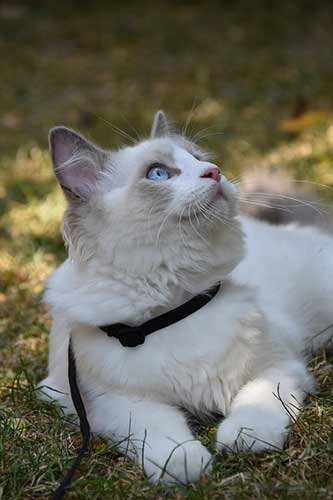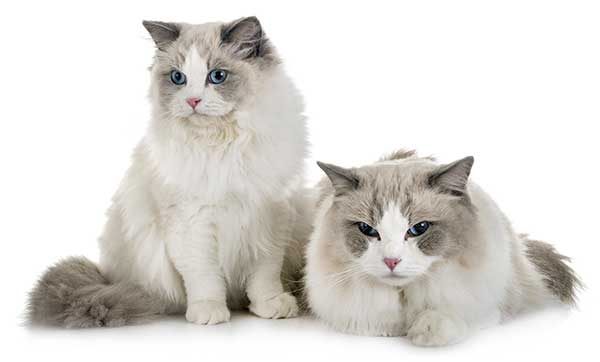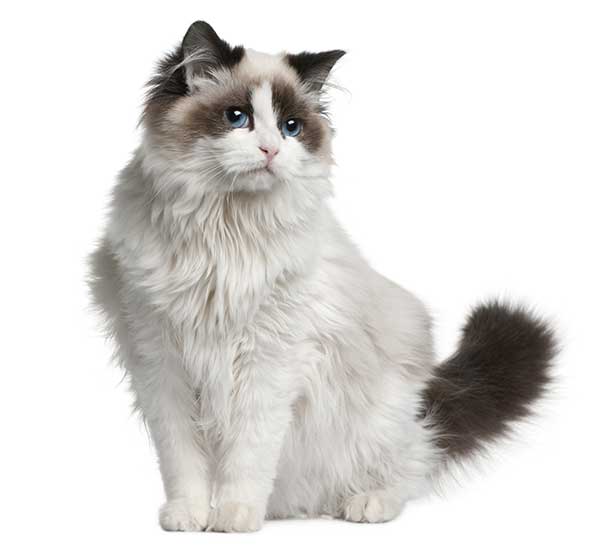Owning a cat is one of the most human fulfilling experiences. These furry, little friends are incredibly energetic, playful, and can make an otherwise boring day lively and colorful.
One of the best things about owning a cat is that there’s a long list of breeds to choose from.
Cat breeds vary in both physical and behavioral characteristics.
If you’re selecting a breed based on its physical traits, some of the things you’ll need to consider include the cat’s size, color, and general appearance.
And if you’re choosing a cat depending on its behavioral characteristics, there are similarly numerous factors to put into consideration.
For instance, some cats are highly domineering, and don’t do well in a family with kids or other pets. Other behavioral aspects include the affinity for water, degree of playfulness, vocalization, etc.
But regardless of how charming cats are, they all come with risks of allergy. And as you may have guessed, cat allergies vary with breeds.
Now, let’s consider the case of Ragdoll cats, and you could be wondering, Are Ragdoll Cats Hypoallergenic?
Unfortunately, Ragdoll cats are not hypoallergenic. Like most other cat breeds, Ragdolls come with risks of allergy, both to humans as well as other pets in the home.
But there’s a saving grace – Ragdolls don’t have an undercoat. The lack of an undercoat implies that Ragdoll cats shed less compared to felines with an undercoat.
So, while they are not hypoallergenic, they carry considerably less allergens. Even better, female Ragdolls and kittens produce less of the pesky cat allergen, which makes them all the more safe to have around.
Read on for more insights on the topic.
Table of Contents
What Causes Allergy in Cats?
Most cat allergies come from allergens that reside in a cat’s dander (dead skin), fur, as well as saliva and urine. These allergens are ever-present and active.

Besides residing in your cat’s body, cat allergens also tend to circulate freely in the air. Some of them might settle on your clothing, furniture, bedding, scratching posts, and other items in your home that your cat frequently comes into contact with.
That means you can contract the allergens any time and develop an allergic reaction.
Most people develop allergic reactions after inhaling or swallowing cat allergens. Generally, people with underlying respiratory conditions, such as asthma and bronchitis, are at a higher risk of suffering cat allergies.
When the allergens enter your body, your immune system mistakes them for something very harmful. So, it responds by making antibodies in a bid to fight off the substances. The action of your antibodies on the allergens is what results in allergy symptoms.
Symptoms of cat allergy vary from person to person. However, they generally include;
- Runny nose and eyes,
- Skin rashes and itching,
- Inflammation,
- Difficulty breathing,
- Fever and chills,
- Nausea and vomiting,
- Coughing,
- Sneezing, and
- Irritability.
Most people will only experience a handful of the above symptoms. And if you have a strong immune system, most of the symptoms will be mild and short-lasting.
However, people who are allergic to cats are likely to suffer severe allergic reactions like asthma, which might necessitate hospitalization.
It’s also important to remember that even if you’re living with a hyperallergenic cat, your allergic reaction might be due to other causes, such as dust mites and pollen grains.
- EASY TO USE, IMPACTFUL RESULTS: Collect a sample, package it up, and send it securely back. Just register, swab, return with the...
- MOST COMPREHENSIVE BREED & TRAIT: Our test distinguishes over 20+ distinct breeds and 50+ trait markers with the most...
- SCREEN FOR 40+ GENETIC DISEASES: Get peace of mind by screening for 64 health markers associated with 43 diseases for which your...
Last update on 2025-02-11 / Affiliate links / Images from Amazon Product Advertising API
Why Aren’t Ragdoll Cats Considered Hypoallergenic?
We’ve already highlighted that Ragdoll cats do not have an undercoat, which implies they pose lower risks of allergy compared to cats that have an undercoat.
That’s already a strong reason why you might consider acquiring a Ragdoll, especially if you have cat allergies. But does that make Ragdolls 100% hypoallergenic? Absolutely not.
According to professional vets, no cat is truly non-allergenic. Remember that cats not only cause allergy through the dander in their fur, but also through their saliva and urine. So, while Ragdolls do not have an undercoat, they can still carry allergens in their urine or saliva.
What complicates the situation is the fact that most cat owners cannot tell which cat allergy they have. The mere fact that you’re not allergic to cat dander doesn’t make you totally immune from the animal’s saliva, urine, or other body fluids.
So, if you frequently suffer allergic reactions after handling your Ragdoll cat, you may need to consult your dermatologist. That’s the only way you’ll know the kind of cat allergens you got exposed to, and which part of the cat’s body they came from.
But even if you’re relatively immune from the allergens in your Ragdoll cat, it’s important to note that you’re not out of the woods yet.
Ragdolls are highly affectionate cats that love to be petted and cuddled, which means they frequently come into close contact with their human owners. Plus, these cats possess long coats that require grooming, further increasing your exposure to their allergens.
Fortunately, there’s a saving grace to owning Ragdolls as far as cat allergy goes.
First, Ragdolls shed less compared to most cat breeds. These cats shed twice a year, typically around spring and fall. As they shed less, Ragdolls require less grooming, which reduces your exposure to the allergens in their fur.
Also, research indicates that Ragdoll cats produce less of the allergy-inducing protein Fel D 1. Kittens, females and neutered males produce even less of this protein.

But are ragdoll kittens hypoallergenic?
Again, no cat is truly hypoallergenic. However, Ragdoll kittens carry minimal risks of allergy, considering they produce less of the Fel D 1 protein.
Other Features of Ragdoll Cats
So far, the verdict is that while Ragdoll cats are not 100% hypoallergenic, they carry significantly reduced risks of allergy. But that’s not the only thing to love about Ragdolls.
Ragdoll cats are known for their calm disposition and easygoing personality, which makes them ideal for homes with young kids.
Here are some fun facts about Ragdoll cats;
1. History
The Ragdoll cat is relatively new compared to most other cat breeds. Ragdolls were created in the 1960’s in California, by a cat breeder known as Ann Baker.
Having lived with cats for years, Baker was interested in creating a cat breed that was beautiful, mellow, and easygoing.

After several generations, she was able to create her first Ragdoll cat. The cat was identified with its large size, outgoing personality, and non-matting fur, traits that it has passed over through generations. The original mother of the modern Ragdoll cat was white.
In 1993, the Cat Fanciers Association (CFA) started registering Ragdolls. The cat’s popularity kept surging, ostensibly due to its incredible beauty and pleasant personality.
Today, Ragdolls are ranked as the fifth most popular cat breeds presently registered by the Cat Fanciers Association (CFA).
- FORMULATED FOR PUREBRED RAGDOLL CATS: Royal Canin Ragdoll Adult Cat Food is formulated to meet the nutritional needs of purebred...
- HEART HEALTH: An exclusive blend of nutrients like taurine, EPA, and DHA helps promote good cardiac health
- SKIN AND COAT: Essential nutrients nourish skin and coat, helping to keep hair healthy and beautiful
Last update on 2025-02-12 / Affiliate links / Images from Amazon Product Advertising API
2. Physical Characteristics
Ragdolls can achieve a height of between 11 and 13 inches at their shoulders. Males are generally larger than females.
Adult males can grow up to 20 pounds, while females generally average between 10 and 15 pounds.
Ragdolls feature medium-length and silky coats that come in different color patterns.
Generally, all Ragdoll cats are born white, and they only develop different color patterns as they grow up. The cats are described as color-pointed, which implies that they sport lighter color hues in their bodies than their extremities.
Some of the popular color options include;
-
- Blue – Blue Ragdolls have very light gray bodies and darker shades of gray in their extremities.
- Seal – Creamy white bodies and dark-brown extremities.
- Chocolate – Light-colored bodies and light-brown extremities.
- Lilac – Light bodies and gray extremities.
- Flame – Light bodies and red or orange extremities.
- Cream – Ivory-colored bodies and creamy extremities.
Despite the wide range of color patterns in their bodies, most Ragdolls have a blue eye color.
In terms of life expectancy, Ragdolls can live between 13 and 15 years, or even more. The cats reach full maturity from 3 to 4 years.

3. Behavioral Characteristics
i. Affection level
Ragdoll cats are highly affectionate and attentive to their owners. They’re technically lap cats that love to be scooped up, petted, and cuddled.
ii. Temperament
Ragdolls have a cool temperament, and hardly get annoyed. They’re super-friendly cats to have around, which makes them ideal for homes with other pets and young kids.
iii. Exercise needs
They are relatively playful. They pack moderate energy levels compared to other cats.
iv. Intelligence
Ragdolls are some of the most intelligent cats. Due to their high intelligence, these cats are incredibly easy to train.
v. Shedding
They don’t shed as much as other cats, especially if they live in cooler climates.
vi. Vocalization level
Medium.
vii. Survival skills
Unfortunately, Ragdoll cats don’t have sharp survival skills, which makes them more ideal for the indoors.
And considering that Ragdolls are highly trusting and naïve cats, allowing them to venture outdoors might expose them to cat thieves or attacks by other animals.
Last update on 2025-02-11 / Affiliate links / Images from Amazon Product Advertising API
4. Health Issues
Like most affectionate cats, Ragdolls are highly susceptible to separation anxiety. So, if you live a traveler’s lifestyle, always ensure you make provisions for your Ragdoll’s physical and mental stimulation in your absence.
Other common health issues among Ragdolls include;
✔ Feline Hypertrophic Cardiomyopathy – A condition that’s characterized by the thickening of the heart muscles.
✔ Feline Mucopolysaccharidosis – A condition that can significantly impair vision and mobility.
How to Deal With Allergy in Ragdoll Cats
The fear of suffering allergic reactions should not deter you from getting a Ragdoll cat. That’s because there are numerous tips you can implement to stay allergy-free, even if you’re allergic to Ragdolls and cats in general.
The following are some of the ways to deal with Allergy in Ragdoll cats;
1. Bathe the cat regularly
Immediately after bringing a Ragdoll home, get it used to bathing at least once a month. When bathing your cat, use pet-safe shampoo and detergent.
And when you’re done, rinse the cat’s coat thoroughly to remove all the dander that might have accumulated in there. Most importantly, do not over-wash the cat, as you may cause its coat to dry out.
Last update on 2025-02-12 / Affiliate links / Images from Amazon Product Advertising API
2. Groom the cat daily
All cats should be groomed daily, or at least every other day. The best way to groom your Ragdoll is to brush and comb its fur gently.
Grooming will not only lower the risks of contracting cat allergens, but it also helps to keep the cat’s fur glowing and prevent hairballs.
Another way you can improve your cat’s coat is to supplement its diet with Omega 3 fatty acids.
3. Control your environment
You may not eliminate allergens from your Ragdoll’s coat, saliva, or urine. But you can make some changes to your environment to ensure that you cushion yourself even further from Ragdoll allergens.
For instance, clean, dust, and vacuum your home regularly. Also, keep your Ragdoll cat out of your bedroom and remove all the surfaces that Ragdoll allergens can hold onto, such as torn fabrics.
4. Consult your vet
If you frequently suffer allergic reactions despite observing the above measures, you should consult your vet. They’ll be able to recommend allergy-relieving medications, such as acepromazine.
So, Are Ragdolls Hypoallergenic Cats?
No, they aren’t. However, Ragdolls don’t have an undercoat, which makes them less allergenic compared to other cats.
But since you can never be 100% safe from cat allergies, you can practice the measures we’ve highlighted above to stay safe from Ragdoll allergy.







![Oatmeal Dog Shampoo & Conditioner 17oz [USA] 5 in 1...](https://m.media-amazon.com/images/I/41879dA1aHL.jpg)


